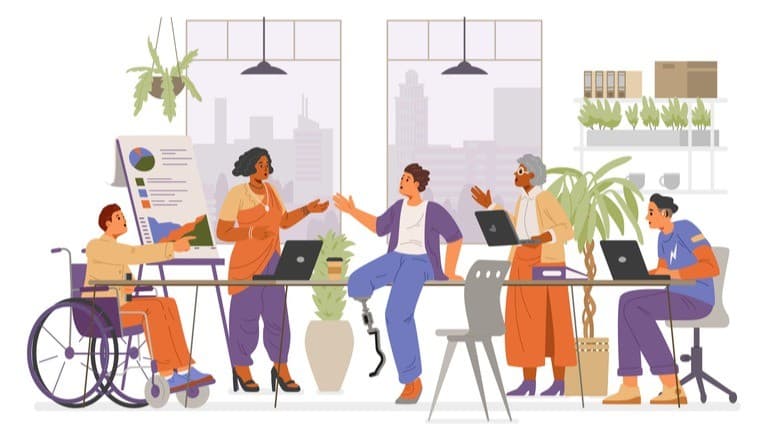
“Culture isn’t built in all-hands meetings or annual reports. It’s built in the moments leaders rarely see – who gets invited to a meeting, who’s heard, whose ideas shape decisions.”
I’ve spent decades in boardrooms and executive roles, watching cultural change initiatives rise and fall. Many were well-intentioned. Few endured.
Diversity programs. Leadership off-sites. Aspirational posters about inclusion. They’re important signals. But they rarely penetrate the day-to-day reality of how people work together.
Why? Because culture lives in the small, often invisible interactions that define how decisions are made.
At Gender Fitness, we’ve built a way to bring those interactions into focus – and give leaders practical tools to build a stronger, more inclusive culture.
This is the story of why.
From conviction to company: changing culture where it counts
I didn’t set out to start a company. I started with a question:
Why does inclusion feel so hard to operationalise?
At an 80-year-old industrial company, I saw first-hand how organisations develop sophisticated defence mechanisms to resist change. You could almost call them “cultural antibodies” because they’re designed to fight off anything that feels foreign to the system.
I heard the same refrains over and over:
It’s too expensive. It’ll take too long. The information’s too subjective. We’d need an army of people to make it work.
This wasn’t just inertia. It was a deeply ingrained organisational immune system, honed over decades. And when the change involves behaviour – not machinery or processes – the resistance is even stronger.
There’s no spreadsheet showing ROI. No obvious throughput gains to point to. So leaders default to what feels safe and familiar.
That raised a bigger question for me: Where does culture actually live?
Sheryl Sandberg’s Lean In offered a clue. She wrote about “pulling up a seat at the table.” That phrase stuck with me because it reframed culture as something dynamic – something decided in the room, moment to moment.
That’s where it clicked: Meetings are the crucible of organisational culture.
Meetings decide:
- Who’s invited.
- Who’s heard.
- Whose contributions influence the outcome.
Change those dynamics and you change your organisation.
What’s more, meeting data is objective. Unlike surveys or sentiment reports, leaders can’t dismiss it as “too subjective.” It’s right there: invitations, attendance, speaking time, decisions.
This became the foundation for Gender Fitness: a lightweight technology that surfaces those patterns, nudges leaders in real time, and makes inclusion a measurable practice.
It wasn’t just theory. We tested the concept with Microsoft. During our pilot pitch, one of their senior leaders quietly typed in their internal chat:
“This is going to be a game changer.”
When your second-largest customer says that about a concept, you know you’re onto something transformative.
Small interventions, big ripple effects
One experience cemented my conviction that this was the right path.
I was in a meeting with senior consultants – two men and a more junior woman. Predictably, the senior partner dominated. The middle manager filled gaps. The junior associate, who’d likely done most of the prep, barely spoke.
I watched her lean forward a few times, ready to contribute, only to be cut off. When a pause finally came, I said:
“You look like you’re about to ask something, what’s on your mind?”
Her answer was insightful. It shifted the discussion. For the rest of the meeting, she contributed more, visibly growing in confidence. It was a minor intervention. But imagine the alternative: she flies back, having stayed silent after hours of prep. Deflated. Disengaged.
Now imagine if every leader noticed those moments. What if every meeting gave people like her a chance to shape outcomes? What if organisations unlocked the ideas sitting quietly in the room?
Why leaders need to slow down and how
Here’s the challenge: our brains aren’t wired for this. As Daniel Kahneman explains in Thinking, Fast and Slow:
Fast thinking is intuitive and efficient. Slow thinking is deliberate, analytical and energy-intensive.
In meetings, fast thinking keeps us leaning on familiar voices and familiar ideas. It feels efficient but often shuts down diverse perspectives.
Slow thinking requires leaders to pause and notice who’s speaking (and who isn’t). To create space for different inputs.
But that’s hard – especially after six back-to-back meetings when your brain is running low on glucose (which fuels 25% of your body’s energy). Your brain actively resists it. It wants to preserve energy for the next sprint. It prefers fast thinking because it feels familiar, comfortable, safe.
As a CEO, I get it. Decision fatigue is real. But I also know that defaulting to fast thinking can cost organisations the very innovation and engagement they need to stay competitive.
This is why leaders need systems that prompt them to engage in slow thinking – not because it’s easy, but because it leads to better decisions.
Gender Fitness does exactly that. It surfaces data from everyday interactions, helping leaders identify where inclusion is (or isn’t) happening. It nudges people to make small, intentional interventions with big ripple effects.
Because culture change isn’t about bold statements. It’s about thousands of micro-moments of inclusion that add up to stronger teams, smarter strategies, and measurable business outcomes.
What happens when you build your culture muscle?
Just like physical fitness, cultural fitness isn’t built overnight.
It requires: Consistent practice. Honest measurement. Leaders willing to do the reps.
The payoff? Higher-performing teams. Better retention of top talent. Stronger innovation and customer outcomes.
And in a world where talent and trust drive competitive advantage, leaders who don’t invest in this muscle will be left behind.
Ready to make inclusion measurable?
I genuinely believe most leaders want to create inclusive cultures. The intent is there; what’s often missing are the practical tools and real-time insights that make inclusion tangible and actionable, not just aspirational.
Too many diversity and inclusion initiatives get stuck at the conceptual level or dismissed as “nice to have” rather than “must-have.”
Leaders face endless challenges: how to measure progress meaningfully, how to keep accountability without creating extra burden, and how to embed inclusion into everyday leadership decisions.
That’s exactly why we built Gender Fitness. Our platform moves beyond good intentions and abstract goals. It equips leaders with objective data from the very heart of organisational life — meetings, the places where decisions, influence and culture are truly shaped.
Gender Fitness helps leaders operationalise inclusion as a business lever – a strategic advantage that drives performance, innovation, and retention – not a box-ticking exercise or a compliance checkbox.
It’s about giving leaders the confidence and clarity to intervene in the moment, to unlock hidden talent, and to build teams that thrive through diversity of thought and voice.
Inclusion becomes measurable, manageable, and most importantly, repeatable.
If you’re serious about turning culture into a competitive advantage, not just a buzzword, I’d love to talk about how Gender Fitness can help you start building your culture muscle today.
